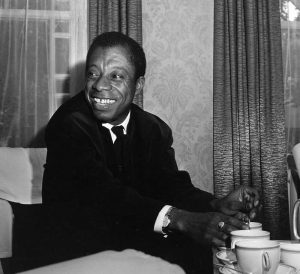James Baldwin was born in New York City on August 2, 1924, and his centenary invites celebration of the work of one of the 20th century’s key voices. A prolific author, his essays, novels and plays are amongst the most searing documents of the African American freedom struggle. He was also a public figure appearing in TV debates about civil rights in America.
Baldwin was deeply inspired and influenced by jazz throughout his life – he was a close friend to many jazz legends from Miles Davis and Ray Charles to Nina Simone and Roy Ayers. As a young aspiring writer in the 1940s, he worked menial jobs during the day and by night, sang and played guitar in Greenwich Village cafes.
Baldwin’s writing about jazz, identity, race and politics has also been a constant source of inspiration for generations of jazz musicians. One of the most recent is Meshell Ndegeocello whose latest album “No More Water: The Gospel Of James Baldwin” is a prophetic musical odyssey inspired by Baldwin’s autobiographical account of black life in New York, “The Fire Next Time” (1963).
Baldwin’s deep insight into African American experience is an enduring resource for anyone who wants to understand the well from which jazz sprung. These insights, lessons and warnings are set out in Baldwin’s own words.

Jazz into Writing
Musicians often featured prominently in Baldwin’s novels. His best selling 1962 novel “Another Country” tells the story of jazz drummer Rufus Scott who is driven to suicide by racism. Commenting to the New York Times, Baldwin reflected: “I think I rather helplessly model myself on Jazz musicians and try to write the way they sound.”
He also published critical essays on blues singers like Bessie Smith and Ma Rainey as well as accounts of the cultural and historical significance of gospel music and soul singers like Aretha Franklin.
Roy Ayers counts him as his favourite author, and to this day Ayers lives in the New York apartment where James Baldwin once lived with his younger brother David. David sang in a gospel quartet called the Melodeers in the 1940s and the journal he kept of their tour of the southern states provided reference material for his brother to write one of his first essays called “Journey to Atlanta” (1948). During the seventies and eighties David worked at Mikell’s jazz club, on Columbus Avenue, New York, where his brother not only met Roy Ayers but also Art Blakey and Wynton Marsalis.
Ayers’ 1984 album “In the Dark” includes an endorsement from Baldwin on the sleeve: “Roy Ayers is witch doctor, clown, saint, historian, and lover, striking notes in a lonely valley, causing dry bones to live. The precision with which he guides his instrument reveals the depth of his love for us all.”
All Jazz is Double-Edged
“It is only in his music, which Americans are able to admire because a proactive sentimentality limits their understanding of it, that the Negro in America has been able to tell his story. It is a story which otherwise has yet to be told and which no American is prepared to hear,” wrote Baldwin in his 1951 essay, “Many Thousands Gone.” While white America is able to understand something of the black experience through listening to jazz, Baldwin observed that the meaning within the music is not inherently legible to black people solely because of racial identity.
As a young gay, black writer, Baldwin was doubly constrained by racism and homophobia, and in 1948 he fled America for Paris, in search of freedom. He spent time in the mountains of Switzerland between 1950-53 with his lover, the Swiss painter Lucien Happersberger, where he wrote the essays that appeared in his collection “Nobody Knows My Name.” He wrote: “There, in that alabaster landscape, armed with two Bessie Smith records and a typewriter, I began to try and re-create the life that I had first known as a child and from which I had spent so many years in flight. It was Bessie Smith, through her tone and her cadence, who helped me dig back to the way I myself must have spoken… and to remember the things I had heard and seen and felt. I had buried them very deep. I had never listened to Bessie Smith in America (in the same way I would not touch Watermelon)…”
Baldwin points to the psychological damage racism inflicts, alienating black people from their own culture which is stigmatised – that black people who didn’t want to be confined by the straitjacket of race wouldn’t eat watermelon or fried chicken or listen to the blues. Listening to that pair of Bessie Smith records helped Baldwin repair the connection with his past and enabled him to finish his first novel, “Go Tell It On The Mountain” (1953). It’s a book about power and the complexities of the Black church where Baldwin had struggled to reconcile his role as a teenage preacher whilst living within the shame about his queerness.
Baldwin’s sexuality and emotional life is the subject of much speculation today. Biographer, James Campbell who spent time with Baldwin writes, “However much of a bohemian and sexual outlaw he might have seemed at times, Baldwin held on to the ideal of love.” He had an affection for soul music’s ballads of love and artists like Aretha Franklin, Donny Hathaway and Randy Crawford.

Let Love Remove Your Mask
Another warning in Baldwin’s writing is the re-inscription of racist myths by white jazz enthusiasts. The original 1950s ‘hipsters’ and ‘beats’ adopted jazz as a subcultural soundtrack of vitality and sexual freedom. Norman Mailer wrote a famous essay in 1957 called “The White Negro: Superficial Reflections on the Hipster.” In Mailer’s argument, jazz appeals to the sensual, the improvisational, and the immediate, or what he calls the “burning consciousness of the present.”
Baldwin met Mailer in Paris and although there was admiration and friendship between them, he found Mailer’s thesis confused and ultimately insulting. Baldwin reflects on his relationship with Mailer in his essay “The Black Boy Looks at the White Boy.” He quotes a passage from Jack Kerouac’s “On The Road “in which the novel’s white protagonist expresses a desire to ‘be black’ as the white world offered ‘not enough ecstasy…not enough life, joy, kicks, darkness, music, not enough night.’
Baldwin dismisses these white delusions in a summary fashion: “this is absolute nonsense, of course, objectively considered, and offensive nonsense at that: I would hate to be in Kerouac’s shoes if he should ever be mad enough to read this aloud from the stage of Harlem’s Apollo Theatre.” When what’s ‘cool’ and ‘hip’ is cast as racially exotic it reproduces racism rather than challenges it regardless of how much white devotees love and worship their precious jazz records.
Baldwin’s warning and lesson is as relevant to the hipsters of today as it was over half a century ago. For Baldwin, racism damages us all and debases the capacity to love; it requires vigilant questions. He wrote in “The Fire Next Time:” “Love takes off the mask that we fear we cannot live without and know we cannot live within. I use the word ‘love’ here not merely in the personal sense but as a state of being, or a state of grace – not in the infantile American sense of being made happy but in the tough and universal sense of quest and daring and growth.” Shared humanity – in music and life – is not an assumed starting point for Baldwin but a destination to strive towards. Meshell Ndegeocello makes music from these words in her track “Love”.
This Music Begins on the Auction Block
By the end of the 1960s Baldwin saw the assassination of three of his close political allies: Medgar Evers, Malcolm X and Martin Luther King Jr. He feared for his life, and the cumulative effects brought him to the edge of a nervous breakdown. He took up refuge in a hilltop village called St-Paul de Vence in Southern France, where he lived for the last seventeen years of his life. He was visited there by black artistic luminaries like Ray Charles, Josephine Baker, Maya Angelou and Nina Simone.
Miles Davis wrote in his autobiography: “I remember being in awe of him because he was so goddamn heavy, all those great books he was writing, and so I didn’t know what to say to him. Later, I found out that he felt the same way about me. I thought we looked like brothers. I had read his books and loved and respected what he had to say. As I got to know Jimmy, we opened up to each other and became great friends. Every time I went to play Antibes, I would always spend a day or two out at Jimmy’s house in St-Paul de Vence. We would just sit in that great big beautiful house of his telling all kinds of stories, lying our asses off.”
It was in St-Paul in 1979 that Baldwin wrote the essay “Of Sorrow Songs: the Cross of Redemption.” It is his most searching contemplation on the meaning of jazz. The essay purports to be a review of white American historian James Lincoln Collier’s “The Making of Jazz” but the book is dismissed summarily for its remoteness from black experience and critical distance. Baldwin insists that jazz is the medium through which the social death of slavery is confronted and reanimated in sound. He writes with searing clarity: “This music begins on the auction block.”
The Atlantic slave trade stripped Africans of their humanity and reduced them to property without history or culture. It is for this reason that Baldwin writes: “whoever, cannot face this can never pay the price for the beat which is the key to music, and the key to life.” To truly hear this music, we need to confront the conditions in which it is made and its purpose in restoring a history and an experience to those who have been denied it in the name of interests of ‘civilisation’. Baldwin concludes prophetically: “Music is our witness, and our ally. The beat is the confession which recognises, changes, and conquers time. Then, history becomes a garment we can wear, and share, and not a cloak in which to hide; time becomes a friend.” Meshell Ndegeocello’s new album updates this musical witness and offers a realisation in melody, lyrics and rhythm this deepest of lessons from Baldwin’s jazz gospel.
Author’s note: special thanks to Paul Gilroy
Les Back is a sociologist at the University of Glasgow. He has authored books on music, racism, football and culture, and is a guitarist.
Header image: James Baldwin. Photo: Jenkins/Hulton Archive via Getty.


